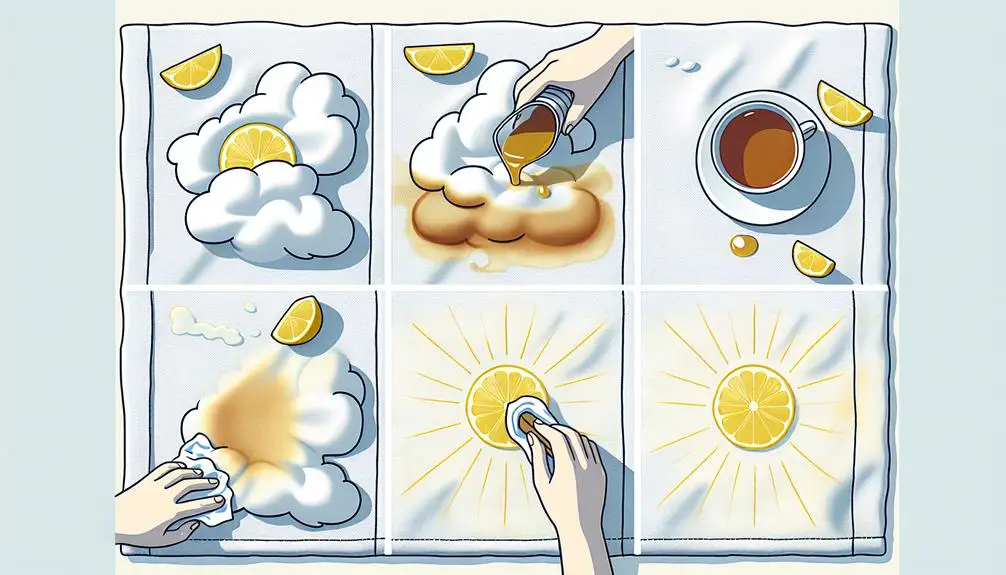To effectively remove tea stains, use vinegar rinses with acetic acid to break down stains, but avoid excessive use to prevent harming tooth enamel. Consider safer alternatives like hydrogen peroxide for brushing and oil pulling with coconut or sesame oil. Try baking soda and lemon paste as a mild scrub, finishing with a vinegar rinse. Herbal mouthwashes containing ingredients like peppermint and tea tree oil can also aid in gently whitening teeth. Experiment with these methods to find the one that works best for you. Discover more about effective tea stain removal techniques in the detailed research provided.
Key Points
- Vinegar rinse breaks down tea stains effectively.
- Charcoal powder adsorbs stains for whitening.
- Oil pulling with coconut or sesame oil removes stains.
- Baking soda and lemon paste scrub away stains gently.
- Herbal mouthwash with peppermint aids in whitening over time.
Natural Remedies for Tea Stains
Looking to naturally remove tea stains? Two effective methods for tackling tea stains on your teeth are the vinegar rinse and the hydrogen peroxide dip.
To begin with, the vinegar rinse involves swishing a solution of vinegar and water in your mouth for about 30 seconds. The acetic acid in vinegar helps break down the tea stains, making them easier to remove. Remember not to overuse this method, as the importance of vinegar can potentially harm your tooth enamel if used excessively.
On the other hand, the hydrogen peroxide dip is a more potent solution. This method entails dipping a toothbrush in hydrogen peroxide and brushing your teeth with it for a minute or two. Hydrogen peroxide is a powerful oxidizing agent that can effectively lift tea stains from your teeth. However, it's essential to use this method sparingly, as prolonged exposure to hydrogen peroxide can lead to tooth sensitivity and gum irritation.
Always consult with your dentist before trying any new teeth stain removal methods.
DIY Teeth Whitening Solutions
Utilize common household ingredients to create effective do-it-yourself teeth whitening solutions.
Charcoal powder, known for its adsorbent properties, is a popular choice for teeth whitening. The porous structure of charcoal helps to trap and remove stains from the surface of the teeth, revealing a brighter smile. To use charcoal powder for teeth whitening, simply dampen your toothbrush, dip it into the powder, and brush your teeth gently for about two minutes. Rinse thoroughly to remove any residue.
Another effective method for at-home teeth whitening is coconut oil brushing. Coconut oil contains lauric acid, which has antimicrobial properties and may help to reduce plaque buildup on the teeth. To whiten your teeth with coconut oil, take a small amount of oil and swish it around in your mouth for 10-15 minutes in a process known as oil pulling. Spit out the oil and brush your teeth as usual. Regular practice of coconut oil brushing can contribute to a brighter smile over time.
Oil Pulling for Stain Removal
To effectively tackle tea stains on your teeth, consider incorporating oil pulling as a natural method for stain removal. Oil pulling is an ancient Ayurvedic technique that involves swishing oil around in your mouth to help remove bacteria, plaque, and stains from the teeth. One of the key benefits of oil pulling is its ability to help whiten teeth naturally by reducing the presence of stains caused by tea, coffee, or other substances.
The oil pulling technique is simple yet effective. Start by taking a tablespoon of coconut oil or sesame oil and swish it around in your mouth for about 15-20 minutes. Make sure not to swallow the oil as it will contain the bacteria and toxins removed from your teeth. After swishing, spit out the oil and rinse your mouth with water. For best results, practice oil pulling consistently to see improvements in the whiteness of your teeth over time.
Incorporating oil pulling into your oral hygiene routine can be a beneficial and natural way to combat tea stains on your teeth.
Baking Soda and Lemon Paste
For effectively removing tea stains from your teeth, consider utilizing a mixture of baking soda and lemon to create a paste with stain-fighting properties. Baking soda, or sodium bicarbonate, is a mild abrasive that can help scrub away surface stains on teeth. When combined with the acidic properties of lemon juice, which acts as a natural bleach, the two ingredients form a potent citrus scrub that can target and break down tea stains effectively.
To make the baking soda and lemon paste, mix a small amount of baking soda with freshly squeezed lemon juice until it forms a thick, spreadable consistency. Gently apply this paste to your teeth using a toothbrush or your finger, ensuring to cover all stained areas. Allow the paste to sit on your teeth for a couple of minutes before rinsing thoroughly with water.
Following this treatment, consider finishing with a vinegar rinse to help restore pH balance in your mouth and further aid in removing any residual stains. This natural method can be a powerful ally in your quest for a brighter, stain-free smile.
Herbal Mouthwash for Whitening
Consider incorporating an herbal mouthwash into your oral care routine for its whitening properties. Herbal mouthwashes are gaining popularity due to their numerous benefits, including their ability to help whiten teeth. These mouthwashes often contain natural ingredients such as peppermint, tea tree oil, and aloe vera, which can work synergistically to improve the appearance of your teeth.
The whitening properties of herbal mouthwashes stem from their natural ingredients that possess mild bleaching effects. Peppermint, for instance, not only freshens breath but also helps remove surface stains on teeth. Tea tree oil, known for its antibacterial properties, can contribute to a cleaner and brighter smile. Aloe vera, with its anti-inflammatory and healing properties, can soothe gums and promote overall oral health.
Using an herbal mouthwash as part of your oral care routine can be a gentle yet effective way to whiten your teeth naturally. Incorporating this into your daily regimen may lead to a brighter smile over time.
Frequently Asked Questions
Can Tea Stains Be Removed by Professional Dental Cleaning?
You must understand that tea stains are resilient. While professional dental cleanings can remove surface stains, deeply embedded ones may persist. Prevention through regular cleanings and limiting tea consumption is key to maintaining a bright smile.
Are There Any Specific Types of Tea That Are More Likely to Cause Stains Than Others?
Certain types of tea, like black tea, have higher staining potential due to their tannin content. To remove tea stains effectively, consider using methods like brushing with baking soda or professional dental cleanings for persistent discoloration.
Is It Possible to Prevent Tea Stains From Forming in the First Place?
To prevent tea stains, adopt preventive measures like immediate blotting, rinsing with cold water, and using stain-fighting techniques. By acting swiftly and applying appropriate methods, you can effectively combat tea stains and maintain pristine surfaces.
Can Using a Straw When Drinking Tea Help Prevent Staining on Teeth?
When sipping tea through a straw, you create a shield for your teeth, akin to a knight's armor safeguarding enamel. This technique aids in preventing staining and maintaining enamel protection for a brighter smile.
Are There Any Long-Term Effects of Having Tea Stains on Teeth Besides Just Aesthetics?
To maintain oral health, consider the long-term effects of tea stains on teeth beyond aesthetics. Stains can lead to health implications like enamel erosion. Prioritize stain prevention through proper oral hygiene and regular cleanings.



